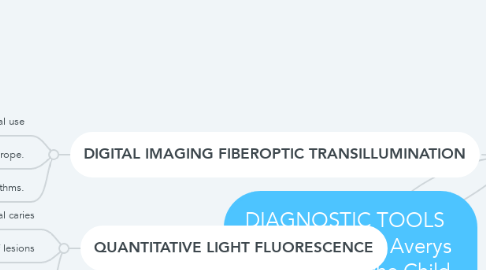DIAGNOSTIC TOOLS McDonald and Averys Dentistry for the Child and Adolescent،10th ed
by Abdulrhman alasmri

1. DIGITAL IMAGING FIBEROPTIC TRANSILLUMINATION
1.1. For at least 30 years a fiberoptic transillumination (FOTI) instrument has been available for clinical use
1.2. it may be used on occlusal and proximal tooth surfaces and the instrument is commonly used, often in place of radiographs, in private practices in Europe.
1.3. Digital imaging fiber optic transillumination (DIFOTI) :the visually observed images are captured with the use of a digital charge-coupled device (CCD) camera and sent to a computer for analysis with dedicated algorithms.
2. QUANTITATIVE LIGHT FLUORESCENCE
2.1. The most extensively investigated technique available for the early detection of dental caries
2.2. QLF enhances the early detection of dental caries and is uniquely useful in monitoring the progression or regression of lesions
2.3. The only significant limitation to this instrument is its inability to detect or monitor interproximal lesions.
3. INFRARED LASER FLUORESCENCE (DIAGNOdent)
3.1. designed to facilitate the detection and quantification of dental caries on occlusal and smooth surfaces
3.2. The identity of the material responsible for the fluorescence is still under investigation, but it appears to be bacterial metabolites, particularly the porphyrins.
3.3. The results of the various in vitro studies have indicated that DIAGNOdent is capable of detecting relatively advanced caries lesions, and DIAGNOdent readings show a very good correlation with histologic evidence of caries, but not with the depths of the lesions in dentin.
3.4. The results of clinical investigations have shown significant differences in readings between different DIAGNOdent instruments with regard to the extent of occlusal caries
3.5. Prudent use of the instrument could identify early lesions that should be considered for preventive rather than restorative treatment.
4. info.
4.1. it is a new era, with technologies capable of both detecting lesions at an earlier stage of development and quantifying the impact of noninvasive professional fluoride treatments such as fluoride varnishes.
4.2. insufficient scientific evidence for diagnostic accuracy regarding fiberoptic methods and quantitative light-induced fluorescence. ( visual-tactile and radiographic examinations)
4.3. Early identification will provide evidence to guide the dental professional in implementing various measures for the reversal and control of these caries lesions.


